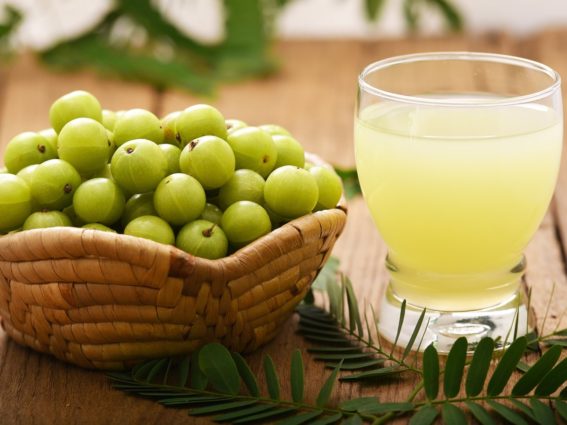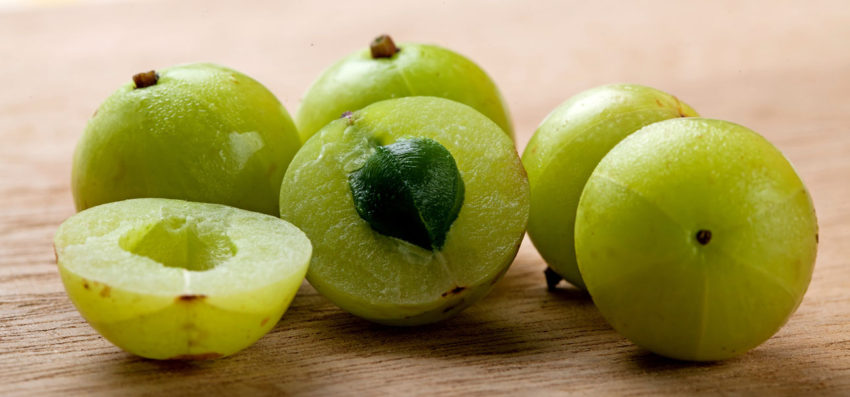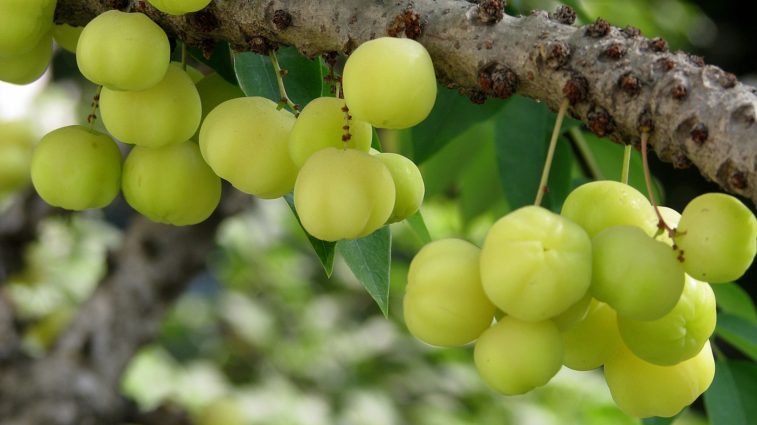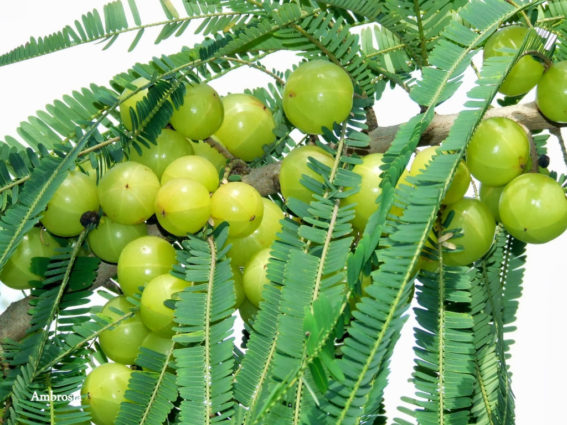AMLA
Amla, Amalaki, Phyllanthus Emblica , Emblica Officinalis, Myrobalan, Malacca Tree, Hindi- Amla, from Sanskrit – Amalaki, Indian gooseberry.
Amla — the strongest natural tonic, antioxidant, Rasayana, elixir of youth, the richest source of vitamin C in nature. Amla increases immunity, prevents premature aging, normalizes the activity of the entire body, treats a wide range of diseases. Amla has anti-inflammatory, antiviral, astringent, antiseptic, regenerating, cooling, diuretic properties. Amla improves blood circulation, blood composition, cleanses the blood. Amla increases hemoglobin, lowers cholesterol, and improves vision. Amla treats hepatitis, diabetes, respiratory diseases, strengthens memory, heart, nervous system, bone tissue, teeth, and gums. Amla improves vision, treats hepatitis, leukoderma. Amla promotes hair growth, prevents hair loss, prevents gray hair, and eliminates dandruff.
Amla is one of the most famous microbalances in Ayurveda, which has the trade name “Emblica”. Amla is a deciduous tree in the family Euphorbiaceae, reaching a height of 5 m. The trunk has a brown bark with easily separated layers, small leaves, and nondescript unisexual flowers in the leaf axils. The fruit is round, smooth, with notches at the base, and has six straight lines dividing the fruit into six equal segments. As the fruit ripens, it becomes yellow or brick-red in color and has a tart, astringent, very sour taste. The Amalaki fruit is less than an inch long but very valuable in its properties. It grows in the dry deciduous forests of India, China, and Ceylon.
Not only the fruits but also the leaves, flowers, seeds, bark, and roots of this tree have healing properties. Fresh Amalaki fruits have a diuretic effect, have the properties of a laxative cooling agent; they also promote digestion and have carminative properties.
Dried Amalaki fruits have astringent properties; Amalaki bark also acts as an astringent.
Flowers also have a cooling effect and a laxative effect. But, mainly for medical purposes, the fruits of Amalaki are used. It is one of the most powerful anti-aging plants in Ayurveda.
The fruit contains a huge amount of ascorbic acid, as well as nicotinic acid, carotene, riboflavin, thiamine bromide, methionine, tryptophan, oils, tannin, gallic acid, glucose, albumin, cellulose, calcium, iron, phosphorus, copper, gum. The fruit contains a lot of flavonoids, tannins, and pectin.
Seeds contain proteolytic and lipolytic enzymes, essential oil. In fresh form, the fruits are used for the preparation of various juices, beverages, and medicines. Amla is one of the most common anti-scurvy natural remedies, as it is the richest source of vitamin C. Fresh fruits of Amalaki are used in the form of medicinal lozenges, tablets, powder, etc. In Ayurvedic medicine, it is used to treat lung inflammation, tuberculosis, diabetes, hemorrhage, and as a digestive stimulant. As a rejuvenating and regenerating tonic and for the treatment of anemia.
The fruits also serve as raw materials for obtaining vitamin C and various extractive preparations.
- Amla can be used during pregnancy.
- Dried Amalaki fruits restore and support new tissues.
- They are a natural antioxidant and immunomodulator.
- Amla is a strong tonic, an aphrodisiac.
- Amla is an effective antiviral, antibacterial and antifungal agent.
- Amla has anti-inflammatory and antipyretic effects.
- Amla-used for anemia stimulates the synthesis of hemoglobin.
- Amla cleanses the liver and blood.
- Amla is effective in diabetes-it reduces and regulates the level of sugar and cholesterol, lowers blood pressure.
- Amla-has a mild diuretic effect.
- Amla is used for chronic lung diseases, inflammation of the upper respiratory tract, as an expectorant, emollient, and bronchodilator.
- Glycosides and saponins of the plant normalize the function of the intestine, eliminating constipation, flatulence, and intestinal colic.
- Natural antiseptics contained in the fruit purify the intestines and inhibit the development of pathogenic microflora in the intestine and genital tract.
- Amla strengthens bones and teeth.
- Amla actively promotes hair growth. Amla stops hair loss and premature graying.
- Amla bark also acts as an astringent.
The face and body mask, made from the fruits of the most important type of myrobalan in Ayurveda – Amalaki, contains all the vitamins, minerals, and trace elements necessary for the skin. It is an excellent rejuvenator, antioxidant, and tonic. Amla gently cleanses the tissues, removes the keratinized layer of the skin, removes slags and toxins. Amla enhances blood microcirculation. Regular masks with Amla make the skin young, healthy and give it a beautiful, natural color.
Amla is used in the following Ayurvedic treatments:
– Physical therapy
– Shastika Shali Pinda Swedana
– Kshiraseka – put a paste of Amalaki powder on the crown of the head to control body temperature. To do this, mix 50 — 100 g of powder with water until it becomes a paste and tie it to the crown of the head.
– Shirolepa – simple without massage, applying the paste on the head, followed by tying a cloth like a handkerchief. This procedure removes excess heat and gives peace of mind to the head.
Methods of use:
— to rejuvenate the body and as a tonic – pure Amalaki powder, take 3-5 g with warm water (for stomach problems – with warm ghee oil) twice a day after meals for 40 days (2 cycles are possible: 40 days — 1 mandala). Anti-aging tonic means that taking the supplement is useful for all organs, from digestion to the senses.
— Amalaki powder is a very good remedy for children, as it is rich in natural vitamin C, strengthens the immune system. It is given in the amount of 3 g.
— in case of eye diseases (ophthalmia, conjunctivitis, etc.) – apply a tincture of seeds or dried fruits of Amalaki for washing and instilling in the eyes. To do this, soak the fruits or seeds overnight in a sterile clay pot.
— to preserve the skin of the face and décolleté area in a young and blooming form, it is recommended to wash in the morning with a decoction of Amalaki – take 1 tbsp. of dry fruits ( or powder), pour a 1 liter of water and cook for 5 minutes. After cooling, put it in the refrigerator overnight. In the morning — to wash. This decoction cleanses the face of fat without soap, improves the appearance of the skin, prevents skin diseases, refreshes and tones.
— Amalaki decoction – 20 ml twice a day after meals. The broth is being prepared: 100 ml of milk per 1 tbsp of Amalaki and boiled until 20 ml.

Additional information:
Amla is a small deciduous tree from the family Euphorbiaceae, reaching a height of 5-8, and sometimes 19 m, with a curved trunk, found throughout India up to a height of 1500 m in the Himalayas. Amla also grows in Sri Lanka and Burma.
Amla belongs to the group of myrobalans — a group of plants growing in the Himalayas, known for their antioxidant, anti-aging properties and having fruits similar to plums or acorns (Greek: Myron — incense oil, balanos-acorn). The main myrobalans are haritaki, bibhitaki, and amla.
Amla has a gray-green bark that peels off easily. The leaves are small, slightly pointed, sparse, light green. During the fall of leaves, branches fall off along with the leaves. The flowers are nondescript, greenish-yellow, collected in inflorescences. Amla fruits are small, round, hard, transparent, ripen from November to February. Unripe fruits of amla are light green in color, when they ripen, they turn greenish-yellow. They have six straight lines dividing the fruit into six equal parts. There is a cultivated variety of amla (gramya). Its fruits are large, smooth, and very juicy. The taste of amla fruits is sour, tart, and astringent. Amla fruits are attached by cuttings directly to the main large branches of the tree, and not to the small branches that branch off from them, as is usually the case. The fruits of amla are very similar to the fruits of gooseberries, hence the plant got the name “Indian gooseberry”, although amla belongs to a completely different botanical family. Amla fruits ripen in autumn and are harvested by hand.
The adult Amla tree perfectly tolerates heat, temperatures above 45 degrees, as well as low temperatures. It can grow on various soils, including in dry and semi-dry places, on salt marshes and soils with high salt content, on depleted soils, on the edges of cultivated land, on abandoned plots.
In India, amla is considered a sacred tree, a divine gift, the embodiment of female maternal energy, the fruits of which are so nutritious and useful that they can feed humanity and save it from many diseases. The amla fruit is an important food source for numerous tribes in India. All parts of the Amla tree have healing properties — fruits, bark, roots, flowers, leaves, seeds. Amla is associated with the goddess Lakshmi. At the beginning of winter, according to the Indian calendar, the Amala Navami festival is celebrated, dedicated to amla, during which ritual rituals are performed to honor the tree as a symbol of good health.
In Sanskrit, “Amla” means “nurse”.
Amla is an extraordinary plant that occupies a key place in Ayurvedic medicine and in Yunani medicine and is included in the” golden row ” of Ayurvedic herbs. Its extraordinary medicinal properties were known and used for several centuries before our era. In terms of its impact, Amla can be compared to such highly effective plants as neem and turmeric. About fifty years ago, Western medicine discovered amla, and after a number of serious scientific studies, the plant became firmly established in Western pharmacology. Amla is also used in traditional Chinese medicine and is called “yuganzi” “yuganzi”, as well as in Yunani medicine and is called “sard kshushk” “sard kshushk”.
Amla is an important ingredient in a huge number of Ayurvedic medicinal and cosmetic preparations. Amla fruits are the richest natural source of ascorbic acid, vitamin C-800 mg per 100 g of pulp. This vitamin C content is higher than that of any other fruit. This is 30 times more than in oranges and 1.5 times more than in fresh rosehip fruits. However, more importantly, amla has a unique formula of ascorbic acid, combined with gallic acid and with a tannin complex, which provides a high resistance of vitamin C, which does not decompose even at a temperature of 100 degrees. In the dried form and in the elixir, it is preserved for up to three years.
Vitamin C is a necessary tool for the synthesis of collagen – the “intercellular cement” that binds together individual cells, for the normal growth and development of the child’s body, increasing its immunity and resistance to infections, diseases, viruses, adverse environmental effects, the full functioning of internal organs, strengthening bone tissue, teeth, hair.
In addition to ascorbic acid, amla contains gallic acid – an important source of polyphenols, tannins – emblican A and emblican B, pectin, citric and nicotinic acids, proteins, fiber, riboflavin, niacin, thiamine bromide, methionine, tryptophan, flavonoids, tannins, carotene, glucose, calcium, iron, phosphorus, copper, cellulose, albumin, gum, and also the most important ingredient is filembin and cytokinins: zeatin, zeatin riboside, zeatin nucleotide, and superoxide dismutase.
Amla fruits contain 3 times more protein and 160 times more vitamin C than apples and also surpass them in the content of minerals and amino acids.
In medicine, amla fruits are used primarily in dried and fresh form, in the form of extracts, juice, drinks, jams, powder, tablets, capsules, plates, as well as bark, seeds, flowers, shoots in the form of infusions, powders, extracts.
Wild amla fruits contain a large amount of fiber. The fruits of cultivated amla are very juicy and contain up to 80% water.
Seeds contain proteolytic and litholytic enzymes, essential oil. The bark and seeds have an astringent effect.
According to Ayurveda, there are six flavors in nature: sweet, sour, salty, bitter, pungent, and astringent. All these tastes should be present in the human diet – then his diet will be balanced and he will be healthy. Amla contains 5 out of 6 possible flavors, i.e. all but salty. Its taste (rasa) is sour (amla) and astringent (kashaya), with a sweet (madhura), bitter (tikta) and pungent (katu) aftertaste (anunasa). Thus, Amla is a great food product that balances the entire body and cures many diseases. For example, although amla tastes sour, it does not increase the acidity, but it also reduces it, and also treats peptic ulcers, since its summed taste is not sour. According to the Ayurvedic classification, Amla is light (lagu) and dry (guksha) and gives a cooling (shita) effect.
Amla-the famous elixir of youth, Rasayana, an adaptogen with powerful energy, one of the most powerful anti-aging plants. Since ancient times, Amla has been used as a tonic that prolongs youth, gives health, strength, and longevity, protects against infections and diseases, gives youth to the body, freshness to the senses, and clarity to the mind, enhancing the love of life, and a sense of joy in life. According to ancient Ayurvedic texts, in particular, Charaka Samhita, a person who takes a tonic based on Amla “will live a hundred years without diseases and ailments.”
In India, there was a unique ritual in which the fruits of amla are hand-picked in the forest on the day of the full moon while chanting the mantra “Om” to fill them with sweet nectar and eliminate the sour and tart taste. It was said that ” a person will live as many full of strength and joy for thousands of years, as many fruits collected in this way, he will eat.” Like many Rasayanas, the Amla depends on the lunar phases and gains its full power during the full moon.
As a Rasayana, amla is consumed independently-in fresh form, in the form of infusions and drinks, juice, jams — and is also included in all Ayurvedic tonics and mixed Rasayanas. Amla is the main component of the famous “Chavanprash” and the cleansing drug “Triphala” (a mixture of amla, haritaka, bibhitaka powders). Amla powder or juice is often taken with honey, turmeric, milk, and lemon juice.
The fruits of amla are eaten. They make chutneys and marinades, sweets, cook jam, grind and make a paste with sugar. Sometimes they are eaten fresh with a little salt and with turmeric. Marinades from amla are very popular in South India, where the fruits of the plant are also eaten in stewed form. In the state of Andhra Pradesh, a sweet dessert is prepared from amla, which is previously soaked for a long time in sugar syrup. Amla is used to make cooling drinks that perfectly quench thirst and have diuretic properties. In India, pharmacies everywhere sell concentrated amla juice with and without sugar, which is diluted with water in a ratio of 1:3, 1:5, and is drunk as a strengthening drink.
Amla has antioxidant, immunomodulatory, regenerating, tonic, anti-inflammatory, antibacterial, antiviral, antipyretic, cooling, astringent, carminative, diuretic, laxative properties.
Amla puts in order, normalizes the activity of the entire body. According to Ayurveda, amla normalizes the activity of all Three Doshas, that is, it balances all the forces in the body. Amla is especially effective for Pitta dosha (fire), due to its cooling effect and sweet aftertaste. Therefore, Amla is especially effective in the treatment of various types of inflammation and disorders associated with digestion and metabolism. At the same time, amla balances Vata dosha (air) due to its sour taste and Kapha dosha (earth) due to its astringent taste and dry effect.

Medicinal properties: Amla is used in the following cases:
- as a nourishing tonic for the whole body, strengthening the immune system, balancing the immune system
- as a means of restoring the body after heavy operations, prolonged illness, childbirth, stress, exhausting work, with general weakness, lethargy, and apathy, restoring vitality and vitality, suitable for both the elderly and young people
- as a strong antioxidant, slowing the aging process and revitalize the body, warning lipid peroxidation in the membranes of cells and regenerative cellular metabolism, protecting the body from the harmful effects of the environment and pollution, free radicals, restoring and supporting the new fabric and does not give side effects
- as a means of improving the composition of the blood, increases hemoglobin, stimulates the release of red blood cells, anemia to normalize the level of cholesterol in the blood
- to strengthen memory, synchronize the work of the right and left hemispheres, improve intellectual abilities, nourish the brain, with atherosclerosis
- to normalize the neuroendocrine system, regulate the function of hormonal organs: thyroid, pancreas, adrenal glands, the sexual system as a means of removing toxins and products of incomplete metabolism (ama) from the body as a powerful anti-inflammatory agent, Amla is used in the treatment of respiratory diseases, asthma, bronchitis, colds, sore throats, flu, pneumonia, as an emollient and expectorant
- in diabetes, regulates blood sugar levels
- to strengthen the gums and teeth, prevents tooth loss, dental caries, bleeding gums, a powerful tool from scurvy
- in diseases of the eye, especially in an inflammatory stage, Amla perfectly corrects myopia, treats glaucoma, conjunctivitis, cataracts (Amla is a strong inhibitor of free radicals, which is one of the causes of cataracts), tincture of Amla washed and buried eyes
- cardiac disorders for the prevention of heart disease and strokes
- for nervous disorders, insomnia
- for disorders of the genitourinary system, to suppress the pathogenic microflora of the genitourinary tract, as a diuretic
- as an aphrodisiac
- as the number one remedy for strengthening and stimulating hair growth, preventing hair loss and prematurely gray hair, eliminating dandruff
- for strengthening bone tissue and nails
- for strengthening blood vessels
- as an antitumor agent
- for gastrointestinal and peptic ulcer diseases, gastritis
- for improving digestion and stimulating appetite
- for colitis, as a carminative
- in hepatitis, disorders of the gall bladder, liver cleanse
- to normalize bowel function, eliminate constipation, gas, purification of the intestine and suppress the development of pathogenic microflora, as a laxative
- as an antiemetic
- for rheumatic pains and pains in the joints, gout
- for the treatment of skin diseases, scabies and itching, fast healing of wounds and ulcers (used fruit juice Amla powder from the seeds and bark of ash from the burned seeds, the paste of leaves)
- at elevated pressure
- at high pH
- dysentery
- in anemia
- diarrhea due to its astringent properties
- for hemorrhoids as a laxative depending on the dose
- as a general tonic and a nourishing tonic during pregnancy, after childbirth, during feeding, contributing to the good development of the fetus
- as a means to strengthen and grow the child’s body
Amla can be used during pregnancy.
Amla is widely known as the plant whose fruit contains the highest amount of vitamin C compared to any other fruit. It is the high content of ascorbic acid that explains the wonderful healing anti-aging properties of the Amla plant. However, recent studies have shown that amla does not contain any significant amount of vitamin C, but it does contain other organic acids and common tannoids (small molecules similar to tannin molecules), as well as some unique tannins that were mistaken for vitamin C during initial studies conducted 50 years ago.
Thus, the main active components of amla, which determine its action, are tannins obtained from gallic and Ellagic acids. The presence of tannins in amla easily explains its medicinal properties, including the treatment of respiratory diseases and gastrointestinal disorders, as well as the rejuvenating effect of the plant. The antioxidant effect of such a complex of substances is more powerful and stable than the effect of vitamin C.
Recently, the Sabinsa Corporation of Amla obtained an extract with a high content of tannins (40% polyphenols, most in the form of tannins). The effectiveness of this extract in the treatment of a wide range of diseases, including reducing blood pressure, blood sugar, improving blood circulation, suppressing the action of carcinogens is very high, which increases the anti-aging effect of the drug.
Dr. Shibnath Ghosal of the University of Benares in 1996 published the results of his research on amla fruit, confirming the erroneous definition of vitamin C. In 1998, he patented a product called Capros, which is an extract of amla obtained in a way that prevents the destruction of tannins. The product contains four polyphenols-emblycanin A and emblycanin B, punigluconin, and pedunculagin, galloillagitannoids (a combination of gallic and ellagic acids, tannoids combined together to produce tannins), and rutin, a type of phenol that is a common flavonoid.
Dr. Ghosal has proven that this product is less susceptible to heat and oxidation than vitamin C, and has a stronger and more stable antioxidant effect. It can be included in medical preparations, as well as in cosmetic complexes aimed at rejuvenation and at preventing the harmful effects of the external environment and other factors.
Amla is widely used in cosmetology. Extracts and Amla oil are added to face and body creams, facial cleansers, masks, milk, gels, and anti-aging cosmetics. However, amla is primarily used in hair care and hair treatment products.
Amla is used in cosmetology due to:
- antioxidant and anti-aging properties
- Amla tones the skin, promotes the change of the cellular epidermis, protects the cells from negative effects, improves blood circulation, complexion, makes the skin supple, smooth and elastic. To preserve the beauty of the skin, it is recommended to wash with a decoction of amla. Amla cleanses the face without soap, refreshes, and tones the skin, prevents skin diseases. Face mask with amla nourishes and rejuvenates the skin, giving it all the necessary elements, vitamins and minerals, removes the rough old layer of skin, removes toxins, improves the complexion, makes the skin glow from the inside.
- antiseptic properties
- Amla is an effective remedy for itching and scabies, eliminates inflammation and redness. Deeply cleanses the pores and eliminates dirt. Cleansers with amla, unlike soap, do not dry and do not tighten the skin.
- astringent, wound-healing properties
- Amla promotes rapid tightening and healing of ulcers and wounds.
- bleaching properties
- Amla is an effective remedy for disturbed pigmentation – freckles, dark spots, pigmentation, and age. Amla brightens the skin by directly affecting an important enzyme involved in the process of melanogenesis. Amla prevents the oxidation of melanin, which results in pigmentation of the skin.
- photosensitizing properties
Amla helps in the treatment of leukoderma (vitiligo). Psoralen, contained in the fruit, helps with leukoderma and protects against UV rays, helping to preserve the natural color of the skin.
Amla is one of the main products in Ayurvedic cosmetology for hair treatment and hair care. Amla is a part of almost all hair products – shampoos, masks, conditioners, rinses, balms, oils, creams, and hair dyes. Extracts and amla oil are used.
Amla oil is included in the composition of hair oil as the main ingredient and is also used in its pure form. Amla is the main component of Triphala hair oil, which also includes haritaki and Bibhitaki.
Amla regenerates cellular metabolism, improves blood circulation, nourishes hair follicles, cleanses the skin, eliminates dandruff, protects against infections. Amla stimulates the growth of hair, makes it strong, elastic, shiny, fills with vitality.
Amla is a highly effective tool for preventing premature hair graying and hair loss. Amla prevents gray hair and reduces the amount of gray hair. Amla is part of the therapeutic agents against hair loss and dandruff.
Amla is suitable for all hair types and for everyday hair care.
Amla restores lifeless, dry, brittle, thinned hair, hair that has been exposed to adverse environmental influences, coloring, after an illness. Amla restores a healthy appearance, beauty, natural shine, strength, strengthens the roots and bulbs, gives softness.
Amla regulates the sebaceous glands, eliminates excess fat, perfectly cleanses and nourishes oily hair.
Amla supports the health of normal hair, gives them antiseptic protection.
Amla enhances the natural color of the hair, giving it a richer and darker shade. Amla does not dye blonde hair. Amla has almost no effect on light-colored and highlighted hair. However, with regular long-term use, as well as immediately after coloring, like many other herbs, it can slightly reduce the whiteness and make the hair color slightly darker.
The bark of amla branches and unripe fruits are used to produce skin dyes.
The popularity of amla fruit and especially its use in Chawanprash and Triphala has led to the emergence of special plantations of amla trees, despite the fact that these trees grow in large numbers everywhere in the forests. At the same time, the following problem occurred. Fruit pickers began to cut off large branches with fruits instead of picking them by hand, climbing up a tree. As a result, trees die and huge areas with amla trees turn into wastelands. Governmental and non-governmental organizations try to educate the population in such a way that they appreciate the gifts of nature and do not jeopardize their economic future. In addition, there are special government programs that encourage the cultivation of amla as a valuable raw material for medicine and the dye industry. In addition to the fruit, the branches, leaves, bark, and seeds of the amla tree can be successfully used for this purpose.

The material is prepared by specialists for informational purposes only. It should not be used as a guide for the treatment of diseases, and it cannot replace professional medical advice, diagnosis, or treatment. In case of illness or any symptoms, you should not self-medicate and should always consult a doctor.



